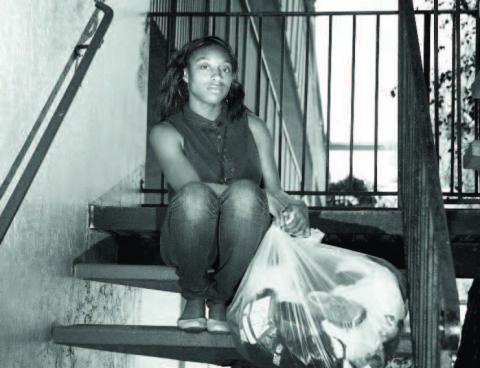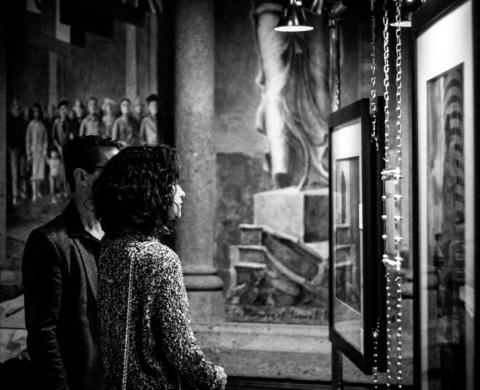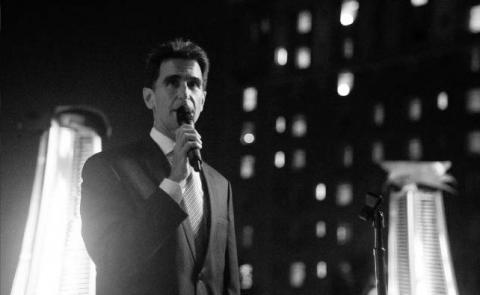
Latrenda Leslie and Foster Youth Luggage. Photo by Ray Bussolari.

Visitors at Lost Childhoods Exhibition at Grace Cathedral. Photo by Jeremiah McWright

Senator Mark Leno speaking at Foster Youth Museum’s Opening Reception. Photo by Jeremiah McWright.
I knew something special was about to happen when I walked up the stairs to Grace Cathedral in San Francisco, CA. It was nearly dusk when I opened the front door and the majestic setting filled my senses: the stained glass, softly glowing in the evening light; the notes from a trio of musicians filling the nave; and a steady flow of people, pulling me stage left into the world of Lost Childhoods.
Silenced No More
An exhibition of Foster Youth Museum, making its San Francisco public debut, Lost Childhoods chronicles youth experiences in foster care. The first of its kind, this traveling exhibition is revealing the voices of foster youth, all too often silenced through the heartaches of loss, and the powerlessness of institutionalization. In the words of Ipo Ma’e, a former foster youth who spoke at the opening reception, “The museum is helping heal people like me and is giving our voices back.”
Upon entering the exhibition, visitors immediately see the impact of foster care, with a display on hygiene products, and a description about the lack thereof in group homes. It is not uncommon for young women to be denied menstruation products and thus use makeshift pads stapled together from toilet paper. Likewise, dental floss and other oral hygiene products are absent making foster youth more prone to cavities and compromised oral care. Another exhibit reveals common foods that are served in group homes, where healthy meals are wanting.
A blend of large format photos taken by photographer and Foster Youth Museum Curator Ray Bussolari, artifacts from current and former foster youth, art, and video portraits, Foster Youth Museum has become the largest collection of its kind, and both youth and the public are taking notice. During an Oakland, CA gallery exhibition, some 2,000 people viewed the exhibit over four weeks. At the historic Grace Cathedral in San Francisco, upwards of 5,000 will take part during its two-week run, from October 15 to November, 1, 2015.
As I continued through the exhibit, I stopped in front of a black and white photo of Latrenda Leslie holding a clear plastic bag with her belongings. This photo, featured in the exhibition’s promotional materials, tells the story of the infamous “foster youth luggage,” into which foster youth place their scant belongings when moving from placement to placement. When you view the photo, Leslie says she wants you to “think about the instability foster youth experience.” And she wants you to know that youth are strong and carry on, but they need your support.
When Art Meets Social Justice
The Right Reverend Marc Handley Andrus, Bishop of the Episcopal Diocese of California, welcomed 400 visitors to the opening reception for Lost Childhoods and called out the importance of this exhibition when he said, “Grace Cathedral has never hosted anything more important than Lost Childhoods, which is putting a face on one our most vulnerable populations – foster youth.” He then called out Senator Mark Leno, also among the speakers, as one of the greatest advocates for justice in California.
Senator Mark Leno has long advocated for foster youth. Working closely with California Youth Connection, the nonprofit behind Foster Youth Museum, Senator Leno has carried a significant piece of foster youth legislation through the California political process nearly every year in office. Bills have improved policies related to housing, healthcare, sibling visitation, and placements of LGBT foster youth. Leno says unequivocally, “Foster youth are our youth – the youth of the state – and we have to take full responsibility for their stories and experiences and make sure the next generation has better experiences.”
Senator Leno talked about tikkun olam, a Judaic concept about repairing the world and committing to the practice of social justice.
Foster Youth Museum represents a new trend in museums, one that combines art and social justice. Art is potent and reaches people in ways that other media do not. Jamie Lee Evans, co-director of Foster Youth Museum, says, “Each time we exhibit Lost Childhoods, we have an opportunity to engage communities – communities of faith, youth advocates, current and former foster youth, and the general public – in a conversation about what it means to support foster youth around housing, healthcare, education and connection. The Lost Childhoods exhibition is where art meets advocacy, and it moves people.”
The Reverends Rebecca Nelson Edwards and Chris Chase can tell you what it is like to be moved by art and compelled to act. Co-directors of Braid Mission, Edwards and Chase saw a private exhibition of Foster Youth Museum last year, and as a result, changed the direction of their ministry to focus on supporting foster youth in San Francisco and started a mentoring program. Moreover, they became “singularly focused on finding the largest stage in the Episcopal Church to expose the powerful stories and art of foster youth.” The historic Grace Cathedral, visited by some 200 people daily, was the obvious choice.
Foster Youth and Faith
Communities of faith have a long history of addressing social justice issues. Among foster youth, faith can be a transformative experience and offer comfort and community; for others, religion has been a source of pain and disconnection.
Angel Woolsey, one of the museum contributors, shares, “Through my journey in foster care I often struggled with faith because child abuse and neglect were not often openly discussed at my church, causing me at times to feel alone with my struggle. Being openly queer as a youth also caused me to feel disconnected, because I constantly heard that I must be saved from my sinful ways. I feel privileged to witness Grace Cathedral welcoming us all, the hurt, the underrepresented, the abused, the neglected, the queer and openly embracing the fact that we are here, we live and are all children of God."
Visitors will see some objects of faith in the museum that former foster youth have donated. The Reverend Rebecca Nelson Edwards, says “the now unsilenced stories, images, and artifacts in the Lost Childhoods exhibition are sacred and we want them to be a source of hope for everyone who visits Grace Cathedral.”
From Disruption and Loss to Transformation
As visitors progress through themes of developmental disruption, institutionalization, powerlessness and loss, they move into transformation. This part of the exhibition tells youth stories about healing and empowerment; after all, the current and former foster youth who share their voices in the museum may have been “lost,” but they are indeed resilient.
One exhibit holds several pieces of legislation that youth advocates with California Youth Connection helped usher into California law. In another display, visitors meet “families related by love” – i.e., former foster youth who have intentionally created family with each other. Together, they share birthdays, holidays and milestones.
Education plays prominently in the museum for its role in healing and transformation. There’s a stunning photo of a young woman reading on a marble bench in the foyer of a library, a massive sculpture to her side. Libraries were a safe place for this former foster youth – a place where she could let down her armor and explore new worlds.
When one former foster youth was asked what childhood activity helped shape her identity, she wrote, “Reading and writing freed me from my day-to-day struggles. I love selfhelp books because they light my fire, which encourages me to be an activist.”
Community Engagement
A hallmark characteristic of social justice museums is community engagement, where the public is invited to interact with the exhibit through personal reflection and participate in wraparound events.
Visitors to the museum are welcome to share their reflections in an Exhibit Journal. For instance, when viewing objects and photos that pertain to loss, visitors might consider whether they have ever been kept from someone they love – and the impact.
Braid Mission, exhibition sponsor, and Grace Cathedral, host, coorganized several events for the community. In a public conversation about Faith & Contemporary Issues, Valentino Luna and Latrenda Leslie, both museum contributors, shared their experiences in foster care, offered recommendations to improve the system, and reflected on the role of faith and God in their lives. With vulnerability, Luna talked about his history as a commercially sexually exploited youth on the streets of Los Angeles and shared his triumphant and successful transition to adulthood.
The audience asked a number of questions – e.g., “How can we support foster youth between the ages of 15 and 18?” Reflecting on her own experience, Leslie recommended that foster youth be given the right to interview prospective foster parents before being placed, and motioned for more personal choice when the child welfare system recommends mental health treatment.
A Vessel for Healing
If we are to improve the experiences and outcomes for foster youth, we have to look beyond the role of the government and child welfare professionals, to include the general public. Foster youth live in our communities and our neighborhoods, go to our schools and places of faith, and want what everyone wants – connection, dignity and love.
On any given day, there are over 400,000 children and youth in foster care in the U.S. – and 26,000 who age out with insufficient resources and support each year. Policy alone cannot change the heartache of loss and disruption, but the public – individual people – can offer connection, mentoring, resources, housing, wellness, and opportunities.
You might wonder why a youth who has so little and has worked so hard would let go of his or her graduation diploma – or any of the objects in the museum for that matter. Put simply, the museum is a vessel for healing. And museum contributors very much want the general public to understand what it means to grow up in foster care, so that members of the community can provide support and connection for foster youth.
If there is one thing that has moved me repeatedly in working on behalf of foster youth, it has been the notion of permanence – and what it means to have permanent connections in this world of ours. In the face of instability, as youth move from placement to placement, I understand that Foster Youth Museum is coming to represent a permanent home where objects, stories and photos – previously silenced – will be held in a safe repository and shared respectfully. “With community support, we can make this a reality so we invite people to support Foster Youth Museum with a donation,” says co-director Evans.
Resources are needed to purchase a storage system in which donated items made of paper, cloth, and photos can be protected from changes in temperature and humidity. Funding will also allow the Foster Youth Museum to hire a staff person who can expand the museum’s reach.
Foster Youth Museum currently maintains three exhibitions: Lost Childhoods, Tribute: Stories of Foster Youth Tattoos, Homeless.
For more information about Foster Youth Museum, visit www.fosteryouthmuseum.org

 Owner/Editor - Chris Chmielewski
Owner/Editor - Chris Chmielewski